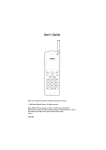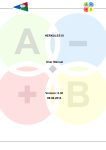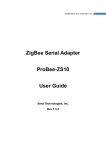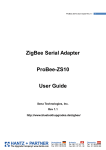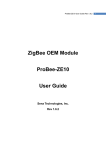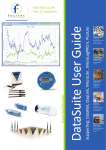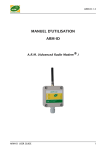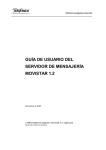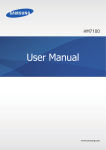Download NOKIA PREMICELL RS232 DATA User's Guide
Transcript
NOKIA PREMICELL RS232 DATA User’s Guide Nokia is a registered trademark of Nokia Corporation, Finland. © 1997 Nokia Mobile Phones Ltd. All rights reserved. Nokia Mobile Phones operates a policy of continuous development. Therefore we reserve the right to make changes and improvements to any of the products described in this guide without prior notice. Nokia Mobile Phones is not responsible for any loss of data, income or any consequential damage howsoever caused. Issue 1 9351672 Important Safety Information FOR YOUR SAFETY Read and follow all warning notices and instructions included in the sales package, in this User’s guide and marked on the product itself. Breaking the rules may be dangerous and/or illegal. Further detailed information is given in this User’s guide. INTERFERENCE All radio transmitting devices may at times incur interference which could affect performance. Only qualified service personnel must repair equipment. CONNECTING TO OTHER DEVICES When connecting to any other device, please refer to its user’s guide for detailed safety instructions, do not connect incompatible products. MAKE BACKUP COPIES Remember to make backup copies of all important data to protect against its possible loss or alteration. Do not drop or knock the adapter, or any way handle it roughly. Do not expose the adapter to moisture or excessive heat. Do not attempt to open the data adapter. Keep the connectors of the data adapter clean. Insert the data adapter correctly into the PremiCell terminal. The cable to be used with this product is in the sales package. If you need additional cables, consult your dealer or network service provider in order to get a compatible cable. Using This Guide The wireless device described in this guide is designed to be used with Nokia PremiCell 09i/18i terminals in a GSM 900/1800 network. For further information about different network services operational in GSM 900 and GSM 1800 networks, please consult with your network service providers. All the safety instructions in the user’s guides of your PremiCell terminal and personal computer also apply when the equipment is used for data calls. TABLE OF CONTENTS Important Safety Information ............................................................................... 2 Your Data Adapter .................................................................................................... 3 Supported Computer Types .................................................................................... 4 Installing the Data Adapter.................................................................................... 4 Introduction to Wireless Communication.......................................................... 6 Factors that May Affect Wireless Data Transmission..................................... 6 Flow Control ............................................................................................................... 7 Communications Applications............................................................................... 8 Data Calls .................................................................................................................... 8 Short Messages.......................................................................................................... 9 Short Message Facility of the Terminal .............................................................. 9 Using Nokia DataSuite............................................................................................. 9 Technical Specifications........................................................................................10 Troubleshooting.......................................................................................................11 Your Data Adapter The data adapter grants you access from your personal computer to network services via your PremiCell terminal. Please ask your network operator for information on the availability of different services. Before you can benefit from the services provided by the data adapter, you may need to subscribe to the corresponding services (data, fax and SMS short messages service) available from your network operator. Note: Use the data adapter and its cable only with PremiCell 09i/18i terminals. Please note that normal landline modem is not compatible with the Nokia PremiCell 09i/18i, so you cannot connect it to the terminal’s phone or fax socket. If you have a fax-modem, however, you can connect it to the terminal’s fax socket to send faxes from your computer. Please also note that normal computer fax applications cannot be used with the direct RS232 data connection. You can have access to computer fax-services with the Nokia DataSuite software, described later in this User’s guide. È1999 Nokia Mobile Phones. All Rights Reserved. 3 Picture 1: AFW-3 data adapter enables the use of advanced communication functions of GSM networks via your PremiCell terminal. Supported Computer Types The data adapter can be used with most modern personal computers equipped with an RS232 serial port. Installing the Data Adapter The sales packet includes: • Data adapter AFW-3 • SIM-cover (modified for data use) • This User’s guide • List of AT Commands Note: Do not start your communications application before you have connected the data adapter to the serial port of your computer and to your terminal. 4 È1999 Nokia Mobile Phones. All Rights Reserved. Installation procedure: Switch off the terminal and your computer. Remove the old SIM cover and remove your SIM card from it (see picture). Attach your SIM card to the new modified SIM cover and insert it into the terminal (see picture). Connect the data adapter to the connector C of your premiCell terminal with the Nokia logo facing up (see picture). Connect the other end of the cable to the RS232 serial port of your computer. Check that both ends of the cable are firmly connected. Now you can power up your computer and PremiCell terminal. To install the modem profiles on your computer, please refer to the handbooks /help files of your computer operating system. È1999 Nokia Mobile Phones. All Rights Reserved. 5 Introduction to Wireless Communication Wireless data connections can be made from most locations where your PremiCell terminal operates. Networks differ from land-line networks in many ways, for example traffic loads and the strength of radio signals may vary in a wireless network and cause handovers. It is recommended that you install the PremiCell terminal to a location where the strongest possible signal can be obtained (see the Low Signal Strength section below). When the signal is strong, the data transmission is most efficient. Factors that May Affect Wireless Data Transmission Noise Wireless connections may be impaired by radio interference from electronic appliances and equipment, as well as from other terminals or phones. Handover As e.g. aeroplanes or big trucks move near the area where the terminal is located, the strength of the channel drops and the network hands the user over to a different cell and frequency, where the signal is stronger. A handover may also occur due to varying wireless traffic loads. Such handovers may cause slight delays. Dead Spots Dead spots are areas where radio signals cannot be received. Electrostatic Discharge (ESD) A discharge of static electricity from a finger or a conductor may cause erroneous functions in electrical devices. The discharge can result in an unreliable wireless connection; the data may then become corrupted and the transmission halts. Should this happen, you may need to restart your computer as well as the terminal, and then establish a new connection. Fast Transients in the AC Power System Sometimes in an AC power system there may be voltage peaks which can disturb a connection. The data may become corrupted and the transmission is halted. Should this happen, you may need to restart your computer as well as the terminal, and then establish a new connection. 6 È1999 Nokia Mobile Phones. All Rights Reserved. Low Signal Strength Due to either distance or obstacles, radio signal strength from a cell site may not be strong or stable enough to provide a reliable connection. Therefore, to ensure the best possible conditions for communication, remember to consider the following points: • The data connection functions best if the terminal is in a stationary position. • Check that the terminal has enough signal strength. Moving the ter- minal within a room, especially closer to a window, may result in a stronger signal. If the signals are not strong enough to support a voice call, you should not attempt to establish a data connection either. For monitoring the strength of the signal see the Nokia PremiCell User’s Guide section 2, Installation. Also keep your terminal and computer 50 cm or more apart to avoid radio frequency disturbances (interference) and to ensure the best possible radio operation. Flow Control Flow control is a method of stopping and restarting data flow between two devices. This prevents one device from receiving too much data from the other, so that its buffer (a temporary data storage area) does not become full and overflow resulting in errors or loss of data. Software and hardware controlled flow controls are the two most commonly used flow control methods. The computer is often able to send data to the terminal faster than the terminal can transmit it to the network. To prevent the terminal buffer from overflowing, the terminal alerts the computer when the buffer is almost full. All data applications do not allow you to change the flow control settings of the application itself, so the only possibility is to change the flow control settings of the terminal. 7 Settings can typically be changed by adding the string S34=1 or S34=2 at the end of the initialization string of your application. The S34 register is used to control the flow control settings of the terminal. The value 1 is the XON/XOFF (or software) flow control, and the value 2 is the RTS/CTS (or hardware) flow control method. You can also use the AT+IFC command to change the flow control settings. See the list of AT Commands for further details on the command. To change the flow control method of your communications application, refer to its documentation. Note: Make sure that the same flow control method is selected for the terminal and for the communications application. Communications Applications You can use your data adapter with a variety of communications applications. One basic setting you may need to check is the communications port (COM port) used by your application. The COM port in your application must correspond to the port that your data adapter is configured to use. See also the Flow Control section above. If you have any problems, turn to the Troubleshooting section at the end of this User’s Guide. AT Commands and S-registers The terminal is designed to be controlled within communication applications with so-called AT commands in a way very similar to a modem. AT commands order the data adapter to perform a task, while S-registers are used to determine how some AT commands will perform a task or to configure other options. Most communications applications have a user-friendly interface that hides AT commands from the user. Advanced users can also operate the data adapter manually with the AT commands. See the List of AT Commands for more information on the available commands and S-registers that can be used to control the terminal. Data Calls There are usually two ways to make a data call. You can either use the pull-down menus of your communications application, or use the AT commands to control the terminal. Once the dial command has been issued, the terminal opens the connection and dials the number indicated. 8 È1999 Nokia Mobile Phones. All Rights Reserved. Short Messages Short Messages Service (SMS) messages are short text messages of up to 160 characters which can be transmitted over a digital wireless network. It is possible to send SMS messages to digital wireless phones or fixed wireless terminals from other wireless devices or remote computer terminals. These short messages will then be stored by the network service centre until delivery and are acknowledged upon receipt. Short messages are always sent first to a Short Message Service Centre run by the wireless network, which then forwards the message to the recipient. Short Message Facility of the Terminal You can display the received messages by using the keyboard of your computer. To activate the Nokia SMS Interpreter, give the AT command AT*C (see the list of AT Commands for more details on the command). You can access SMS services more conveniently via specific SMS applications, e.g. Nokia DataSuite (see the Using Nokia DataSuite section below). Using Nokia DataSuite You can use Nokia DataSuite to send and receive SMS messages on your computer via the PremiCell terminal. Nokia DataSuite includes a comprehensive set of features. These include, e.g., fax, file transfer, e-mail and Internet access. Note: To use DataSuite, you need to have a Nokia AFW1 data adapter (accessory). For more information on your DataSuite software, see the Installation guide included in the DataSuite sales package and Nokia’s web-site at www.nokia.com. È1999 Nokia Mobile Phones. All Rights Reserved. 9 Technical Specifications Data Facility • Non-transparent bearer service • AT Command Set with industry de facto extensions, and extensions from the European Telecommunication Standard ETS 300642 and from V.25ter • V.25bis Command Set • Data Terminal Equipment controlled dialling and answering • Supported data rates: 300, 1200, 2400, 4800, 7200, and 9600 bits/ Short Messages Facility • European Telecommunication Standard ETS 300585 • Nokia SMS Interpreter DTE Data Rates • 300-19 200 Terminal Parameters • Asynchronous • Data bits: 7 or 8, Stop bits: 1 or 2 • Parity: none/odd/even Flow Control • Hardware (RTS/CTS), or software (XON/XOFF), or both, or none Stored Configurations • Two user-definable sets, User Profile 0 and User Profile 1 Terminal Interface • Compatible with: Nokia PremiCell 09 and Nokia PremiCell 18 Specifications are subject to change without notice. 10 È1999 Nokia Mobile Phones. All Rights Reserved. Troubleshooting Overview This chapter points out the basic problems that could occur when operating with the data features of the PremiCell terminal. If the information is not transferred from the transmitting device to the receiving device, the cause of the error could be in the equipment at either end. It could also be in the communications application or the result of a poor communication line. Incompatibilities may also cause problems. With the AT command ATF, you can restore the factory settings of the data adapter including all the S-register settings. You should note, however, that this command does not save them. If you want to save the factory settings for further use, save them either with the command ATW0 or ATW1 in either User Profile 0 or User Profile 1. When you change Sregister settings, the Active User Profile changes. New settings in the active profile are not permanently stored unless the command ATW0/1 is issued to the terminal. È1999 Nokia Mobile Phones. All Rights Reserved. 11 Table 1: Solutions for difficulties you may have when establishing a connection between terminal and computer. Symptom The terminal does not respond Action 1 Make sure that the adapter is properly inserted into the terminal and the computer. 2 Make sure that the communications application has the correct COM port selected. Terminal does not respond correctly during initialization Terminal does not echo back AT commands correctly Check that the modem type and its initialization string are correct for the terminal. See the documentation of the application you are using for further details on how to change or customize the modem settings. 1 Make sure that all AT commands are terminated with a carriage return (<ENTER>). 2 Use your communications application to verify that the computer has a valid character format. See the Technical Specifications for the valid formats. 3 Make sure that the computer’s nominal data rate is supported by the terminal. 4 Issue the ATE1 command to ensure that characters can be echoed back to your monitor. An OK response should appear. Then, enter an AT command and carriage return to check that characters are displayed on the monitor. 12 È1999 Nokia Mobile Phones. All Rights Reserved. Table 2: Solutions to problems that may occur when your terminal fails to start communication. Symptom The terminal starts dialling, but does not make a connection. Action 1 All the channels in your area may be occupied at the moment. Wait for a few seconds before redialling. This may also occur when you are dialling a voice call. 2 Move to a better position and try again. You may have a poor connection. 3 Some network operators may not support autobauding. Try typing the command ATS35=6 in your application. This command selects a fixed transmission speed of 9600 bps. If this does not help, try entering other values for the S-register. See the List of AT Commands for further information on other S-register values. 4 Data services are not necessarily automat- ically activated in the service subscription of your network operator. If you are not sure whether the services are activated, please contact your local network operator. Terminal does not automatically answer an incoming call. Terminal establishes a connection but then disconnects the call. Verify that the Auto Answer Ring Count configuration option (S-register S0) is set to a value other than 0 (the function is disabled when the value is 0). 1 You may have poor radio communication. Try moving to a better position and dialling again. If the problem persists, an external antenna may be needed. 2 Make sure that the remote modem supports the selected protocol (data mode). È1999 Nokia Mobile Phones. All Rights Reserved. 13 Symptom Data is scrambled/lost during data transmission. Action 1 Make sure that you have the same flow control method selected for the data adapter and for the communications application. 2 Try again. You may have a poor connection. See the above section, Factors That May Affect Wireless Data Transmission in this guide. 14 È1999 Nokia Mobile Phones. All Rights Reserved.















